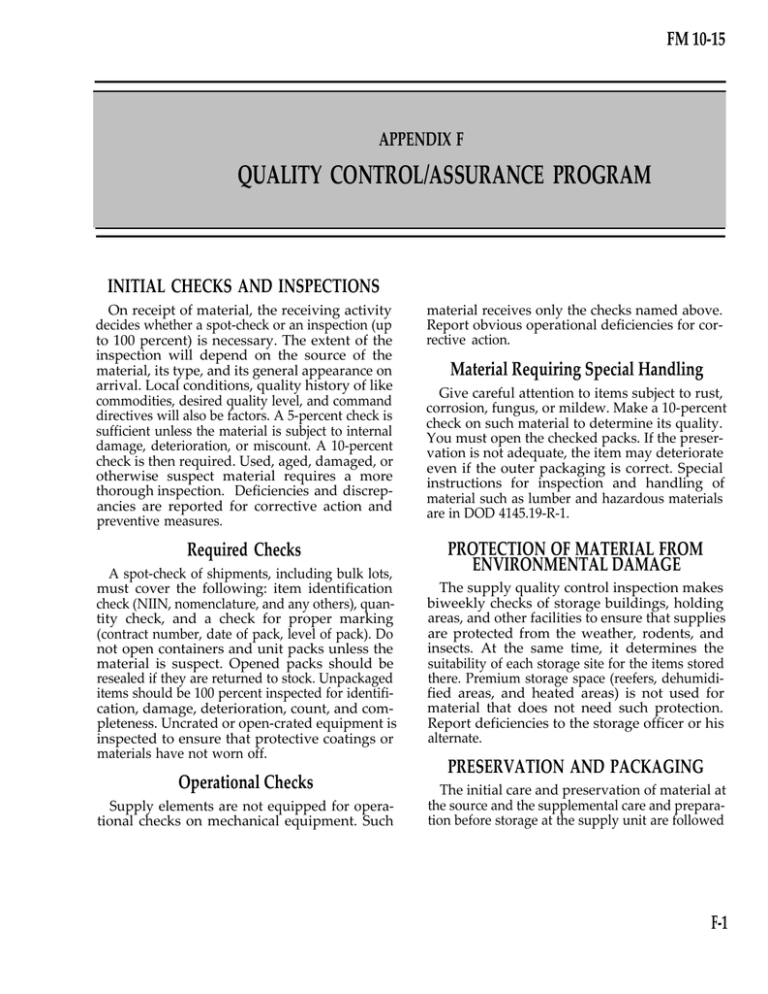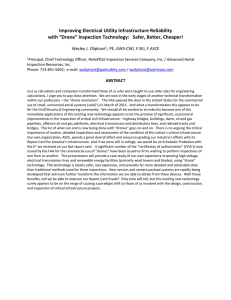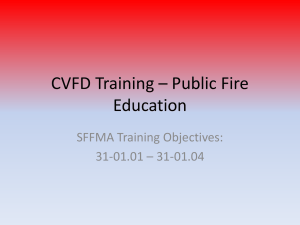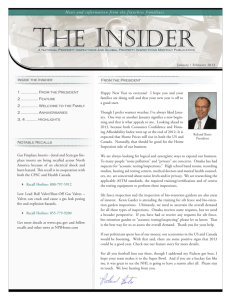QUALITY CONTROL/ASSURANCE PROGRAM FM 10-15 APPENDIX F INITIAL CHECKS AND INSPECTIONS
advertisement

FM 10-15 APPENDIX F QUALITY CONTROL/ASSURANCE PROGRAM INITIAL CHECKS AND INSPECTIONS On receipt of material, the receiving activity decides whether a spot-check or an inspection (up to 100 percent) is necessary. The extent of the inspection will depend on the source of the material, its type, and its general appearance on arrival. Local conditions, quality history of like commodities, desired quality level, and command directives will also be factors. A 5-percent check is sufficient unless the material is subject to internal damage, deterioration, or miscount. A 10-percent check is then required. Used, aged, damaged, or otherwise suspect material requires a more thorough inspection. Deficiencies and discrepancies are reported for corrective action and preventive measures. Required Checks A spot-check of shipments, including bulk lots, must cover the following: item identification check (NIIN, nomenclature, and any others), quantity check, and a check for proper marking (contract number, date of pack, level of pack). Do not open containers and unit packs unless the material is suspect. Opened packs should be resealed if they are returned to stock. Unpackaged items should be 100 percent inspected for identification, damage, deterioration, count, and completeness. Uncrated or open-crated equipment is inspected to ensure that protective coatings or materials have not worn off. Operational Checks Supply elements are not equipped for operational checks on mechanical equipment. Such material receives only the checks named above. Report obvious operational deficiencies for corrective action. Material Requiring Special Handling Give careful attention to items subject to rust, corrosion, fungus, or mildew. Make a 10-percent check on such material to determine its quality. You must open the checked packs. If the preservation is not adequate, the item may deteriorate even if the outer packaging is correct. Special instructions for inspection and handling of material such as lumber and hazardous materials are in DOD 4145.19-R-1. PROTECTION OF MATERIAL FROM ENVIRONMENTAL DAMAGE The supply quality control inspection makes biweekly checks of storage buildings, holding areas, and other facilities to ensure that supplies are protected from the weather, rodents, and insects. At the same time, it determines the suitability of each storage site for the items stored there. Premium storage space (reefers, dehumidified areas, and heated areas) is not used for material that does not need such protection. Report deficiencies to the storage officer or his alternate. PRESERVATION AND PACKAGING The initial care and preservation of material at the source and the supplemental care and preparation before storage at the supply unit are followed F-1 FM 10-15 by periodic inspections. DS units have a fairly quick turnover of supplies. This helps to prevent long-term deterioration, but it does not relieve the supply officer of his responsibility for the condition of the material. In addition to the biweekly inspection of unit storage facilities, cyclical and special checks of the material must be made. Basic guidance is in DOD 4145.19-R-1. More specific instructions are in the storage serviceability standards, supply manuals, and bulletins. Type 2 items have shelf-life periods that may be extended if they meet certain standards after inspection or restoration. Controls are established at the storage facility to maintain records on shelflife stocks. Regardless of the time remaining, shelf-life material is issued by the first-in, first-out rule to ensure its use before the expiration date. Shelf-life material is coded at the source. These codes are listed in AR 708-1. Information on inspections and coding changes is in AR 740-3. Routine Inspections MATERIAL CLASSIFICATION During routine (cyclic) inspections, the emphasis is on ensuring that the first-in, first-out rule is being followed. This is especially important for stock that is known to deteriorate with age. This kind of inspection must be very thorough in areas where large quantities of slow-moving stocks are stored. Where the first-in, first-out rule is not being observed, inspectors notify the storage officer so that action can be taken. Condition codes indicate the condition of material and determine its distribution. These codes show the extent of needed repairs, where repairs can be made, and whether an item is worth repairing. There are strict rules for the use of the codes with material received, stored, or issued. Special Inspections Special inspections of suspect lots, quantities, or items are made on request of higher authority and after periods of hard rains, heavy snows, high winds, and sudden changes in the weather. They are requested by higher authority for a variety of reasons and are carried out according to the need. Inspections after bad weather cover such things as torn or loose protective canvas and coverings; damage from flying debris; water and hail; and loss of preservatives on exposed bare metal surfaces, hydraulic cylinder rods, and gears. SHELF-LIFE ITEMS Items that deteriorate at a known rate are assigned storage time (shelf-life) periods. There are two types of shelf-life items. Type 1 items have shelf-life periods that end after a specified time. F-2 Collection and Classification Because of time and equipment limitations, collection and classification inspectors often cannot make a final decision on the serviceability of an item. Their main purpose is to divide materials into commodity groups and to determine their general condition. A complete inspection is made after the material has been sent to the DSU. Coding At the DSU level, material is inspected and classified by condition codes in AR 725-50. To ensure that the correct code is assigned, DSU units verify the inspection sheets for equipment sent to them from collection and classification inspectors. When verification shows the need for inspection training, it will be provided by quality assistance contact teams. DSU units also inspect and classify organic equipment sent to higher levels of maintenance.



